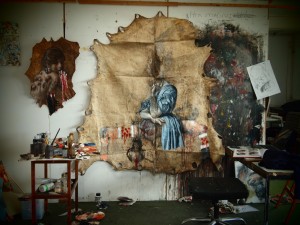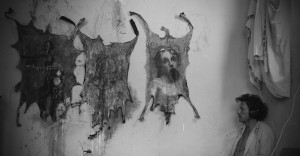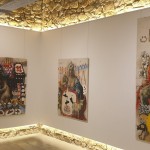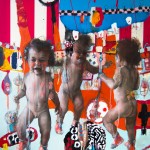Zemecha Paintings - Addis Ababa, Ethiopia
Addis Ababa, Ethiopia: Goat and cow hides – a fabric of daily life there replaced dress pattern paper as a canvas. It felt pre-ordained as a material, I had been drawing in the tribal villages of the south and the glistening hides would be staked out in the sun – like some Mappa Mundi with continents of gristle, rivers of veins. Everyone in the village knew why I might want them, and what their worth was in a trade for matches/soap and razor blades.
“We may start out from Marx’s famous saying about history occurring fist as authentic event and then being repeated as farce. In this way, we may see modernity as the initial adventure of the European West, then as an immense farce repeating itself on a planetary scale, in all those latitudes to which Western religious, technical, economic and political values have been exported. This ‘carnivalization’ passes through the stages of evangelization, colonization, decolonization and globalization, which themselves are historic. What is less visible is that this hegemony, this ascendancy on the art of the global order, whose models seem irresistible….. is accompanied by an extraordinary process of reversion, in which power is slowly undermined, devoured or “cannibalized’ by the very people it ‘carnivalizes’…….it is this dual – carnivalesque and cannibalistic – form we see reflected in every corner of the world…”
Jean Baudrillard - CARNIVAL AND CANNIBAL 2008 Editions de L’Herne.
Cuthbert’s Morning Off – Dress Pattern Paper
I associate the paper with my childhood. It was ubiquitous in the house. My mother looked after the son of a doctor; we would go to the doctors house, I would sit on the floor with the doctors medical books, the colours of the anatomy illustrations, and my mother would sew with these enormous sheets of paper, pinning the fabric to them, each of us doing our own work. I liked that. I wasn’t allowed to draw on it then. I don’t think I wanted to.
Working each painting is like a romantic date, nerves and stuttering, followed by listening, by chancing enough, never too much, keeping stuff back in reserve. To work and keep the conversation with the paint alive; it wouldn’t be art without some rhetorical flourishes, but honesty is the best strategy in the long run.
I am looking not to bore the paper.
There is another memory from around that time; a trip to the National Gallery. I remember two things. One was Leonardo’s cartoon of The Virgin, Child and St Anne. I was aware of big sheets of paper from an early age. A whole gallery full of overworked paintings and then that.
There are technical challenges, the paper is semitransparent, a lot of graphite always tempting itself to dissolve into the turpentine, so I work on both sides of the paper, flipping them around like giant flags. I am intimate with what lies behind it. I am always conscious that there are two surfaces, and only one to choose from.
In the studio they hang, there is a weight of the paint/varnish and the lightness of the paper. Caught by the air they oscillate slightly, swelling breathing presences. I am happy when they have that presence. I want the paintings to be open; I want to open the painting. The paper is perfect as it is; I am always looking to maintain that perfection. I try by paint to seduce it. Seduction is the metamorphosis that keeps its perfection in flow.
It is not sufficient for painters to shy away from meaning. For the work to have meaning then it needs to situate itself, it suddenly has to do work for someone, something else. It subjects itself like a worker to making profit for the system of meaning. Painters take refuge in the thing in itself, the work indivisible in its resistance to meaning, but congruent to Truth. What if a Painting is one of those quasi metaphysical spaces where Truth and meaning come together again? Or rather there is a strategy that oscillates between these two polls, via endless looping detours through the imaginary. The paintings are strategic in that specific aspect.
I didn’t come here for the light. It wasn’t a romantic move in any sense of the word. I had spent the last 7 years in Yemen, Beirut, Cairo and then London. It was a period of enormous reappraisal about my priorities as a painter. I stripped away as much of the theoretical basis of my practice as possible. Internally I felt amputated, like that part of Cornwall, like Redruth – just tethered by the sinew of the railway line. These works began with seismographic drawing trying to re-sense the missing limb. In Redruth town I found a dysfunctional Trumpton, Trumpton after a hundred years of social stagnation; a sinewy knuckle of a place. A place devoid of pretension. I found part of a farmhouse on Carn Brea. I liked it very much. I was drawn to it. The work is rooted in of place where a sense of the civic belies a more visceral underbelly.
C. Anthem. Carn Brea, Cornwall. 2011
Zemecha Paintings – Addis Ababa, Ethiopia
Addis Ababa, Ethiopia: I went and got a studio there for three months. Goat and cow hides – a fabric of daily life there replaced dress pattern paper as a canvas. It felt pre-ordained as a material, I had been drawing in the tribal villages of the south and the glistening hides would be staked out in the sun – like some Mappa Mundi with continents of gristle, rivers of veins. Everyone in the village knew why I might want them, and what their worth was in a trade for matches/soap and razor blades.
The cow hides are immense, 2 metres square. Blank cow hides stacked in the Cornwall studio. Finding sources for paintings in Ethiopia was like shooting fish in barrels, sketchbooks filled with the work to be done, plus a culture that permeated the membrane of my dreams, that bodily taste that I have been immersed in something tangibly squalid and beautiful at the same time.
The paintings adopt ironic strategies that will undermine my voyeurism of otherness. Paintings that address the gnarled humanness of urban/rural Ethiopia through the indulgent detour of the baroque.
C. Anthem. Addis Ababa 2012
Links: Work from Addis Ababa – http://chrisanthem.co.uk/?p=1638 / Mursi sketchook pages – http://chrisanthem.co.uk/?p=184
Cuthbert’s Morning Off – Dress Pattern Paper
I associate the paper with my childhood. It was ubiquitous in the house. My mother looked after the son of a doctor; we would go to the doctors house, I would sit on the floor with the doctors medical books, the colours of the anatomy illustrations, and my mother would sew with these enormous sheets of paper, pinning the fabric to them, each of us doing our own work. I liked that. I wasn’t allowed to draw on it then. I don’t think I wanted to.
Working each painting is like a romantic date, nerves and stuttering, followed by listening, by chancing enough, never too much, keeping stuff back in reserve. To work and keep the conversation with the paint alive; it wouldn’t be art without some rhetorical flourishes, but honesty is the best strategy in the long run.
I am looking not to bore the paper.
There is another memory from around that time; a trip to the National Gallery. I remember two things. One was Leonardo’s cartoon of The Virgin, Child and St Anne. I was aware of big sheets of paper from an early age. A whole gallery full of overworked paintings and then that.
There are technical challenges, the paper is semitransparent, a lot of graphite always tempting itself to dissolve into the turpentine, so I work on both sides of the paper, flipping them around like giant flags. I am intimate with what lies behind it. I am always conscious that there are two surfaces, and only one to choose from.
In the studio they hang, there is a weight of the paint/varnish and the lightness of the paper. Caught by the air they oscillate slightly, swelling breathing presences. I am happy when they have that presence. I want the paintings to be open; I want to open the painting. The paper is perfect as it is; I am always looking to maintain that perfection. I try by paint to seduce it. Seduction is the metamorphosis that keeps its perfection in flow.
C. Anthem. Carn Brea, Cornwall. 2011
- Chris Anthem; Residence Alia, Lebanon 2012
“It is not sufficient for painters to shy away from meaning. For the work to have meaning then it needs to situate itself, it suddenly has to do work for someone, something else. It subjects itself like a worker to making profit for the system of meaning. Painters take refuge in the thing in itself, the work indivisible in its resistance to meaning, but congruent to Truth. But what if a Painting is one of those quasi religious spaces where the two come together again? Truth and meaning. Or rather there is a strategy that oscillates between the two polls, via endless detours through the imaginary. The paintings are strategic in that specific aspect.” (C. Anthem, Lebanon 2012)
Cornwall
I didn’t come here for the light. It wasn’t a romantic move in any sense of the word. I had spent the last 7 years in Yemen, Beirut, Cairo and then London. It was a period of enormous reappraisal about my priorities as a painter. I stripped away as much of the theoretical basis of my practice as possible. Internally I felt amputated, like that part of Cornwall, like Redruth – just tethered by the sinew of the railway line. These works began with seismographic drawing trying to re-sense the missing limb. In Redruth town I found a dysfunctional Trumpton, Trumpton after a hundred years of social stagnation; a sinewy knuckle of a place. A place devoid of pretension. I found part of a farmhouse on Carn Brea. I liked it very much. I was drawn to it. The work is rooted in of place where a sense of the civic belies a more visceral underbelly.
C. Anthem. Carn Brea, Cornwall. 2011



 The Automatic Hand – Dakar, Senegal
The Automatic Hand – Dakar, Senegal “Joust”, Minus 5, Mansourieh, Beirut: 5th
“Joust”, Minus 5, Mansourieh, Beirut: 5th “Fledge” – Millennium Gallery, UK
“Fledge” – Millennium Gallery, UK Paintings Khartoum Sudan – The Teargas
Paintings Khartoum Sudan – The Teargas Dressage – Budapest Art Factory
Dressage – Budapest Art Factory “First we Kill them, then we surround them,
“First we Kill them, then we surround them, 2014/15 Cow Hides – Addis Ababa/Beirut/Cornwall
2014/15 Cow Hides – Addis Ababa/Beirut/Cornwall No Captagon in Raqqah
No Captagon in Raqqah